wheel Citroen C3 PICASSO RHD 2016 1.G Owner's Manual
[x] Cancel search | Manufacturer: CITROEN, Model Year: 2016, Model line: C3 PICASSO RHD, Model: Citroen C3 PICASSO RHD 2016 1.GPages: 296, PDF Size: 9.13 MB
Page 3 of 296
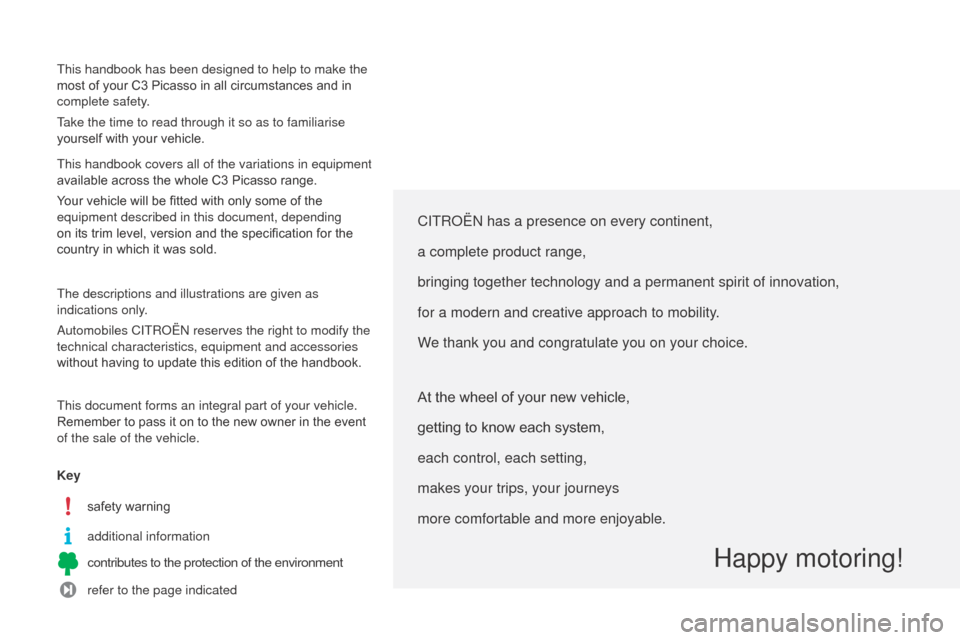
This handbook covers all of the variations in equipment
available across the whole C3 Picasso range.
Your vehicle will be fitted with only some of the
equipment described in this document, depending
on its trim level, version and the specification for the
country in which it was sold.
The descriptions and illustrations are given as
indications only.
Automobiles CITROËN reserves the right to modify the
technical characteristics, equipment and accessories
without having to update this edition of the handbook.
This document forms an integral part of your vehicle.
Remember to pass it on to the new owner in the event
of the sale of the vehicle.
CITROËN has a presence on every continent,
a complete product range,
bringing together technology and a permanent spirit of innovation,
for a modern and creative approach to mobility
.
We thank you and congratulate you on your choice.
Happy motoring!
This handbook has been designed to help to make the
most of your C3 Picasso in all circumstances and in
complete safety.
Take the time to read through it so as to familiarise
yourself with your vehicle.
At the wheel of your new vehicle,
getting to know each system,
each control, each setting,
makes your trips, your journeys
more comfortable and more enjoyable.
refer to the page indicated
Key
contributes to the protection of the environment
additional information safety warning
Page 4 of 296
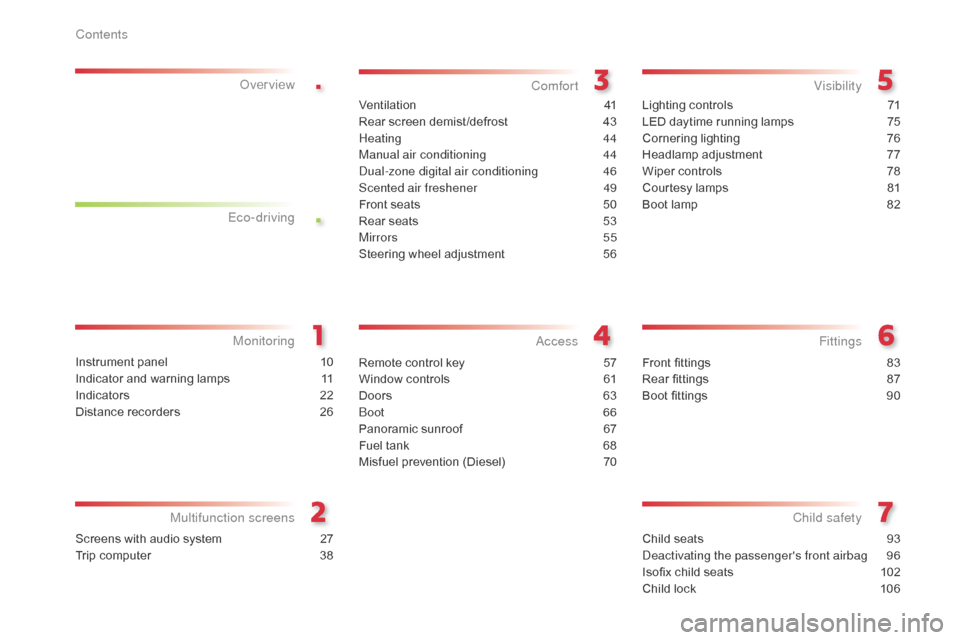
.
.
Child seats 93
Deactivating the passenger's front airbag
9
6
Isofix child seats
1
02
Child lock
1
06
Child safety
Instrument panel 1 0
Indicator and warning lamps
1
1
Indicators
2
2
Distance recorders
2
6
MonitoringOver view
Screens with audio system 2
7
Trip computer
3
8
Multifunction screens
Ventilation 41
Rear screen demist /defrost
4
3
Heating
44
Manual air conditioning
4
4
Dual-zone digital air conditioning
4
6
Scented air freshener
4
9
Front seats
5
0
Rear seats
5
3
Mirrors
55
Steering wheel adjustment
5
6
Comfort
Remote control key 57
Window controls
6
1
Doors
6
3
Boot
66
Panoramic sunroof
6
7
Fuel tank
6
8
Misfuel prevention (Diesel)
7
0
Access
Lighting controls 7 1
LED daytime running lamps
7
5
Cornering lighting
7
6
Headlamp adjustment
7
7
Wiper controls
7
8
Courtesy lamps
8
1
Boot lamp
8
2
Visibility
Front fittings 8 3
Rear fittings
87
B
oot fittings
9
0
Fittings
Eco-driving
C3Picasso_gb_Chap00a_sommaire_ed01-2015
Contents
Page 5 of 296
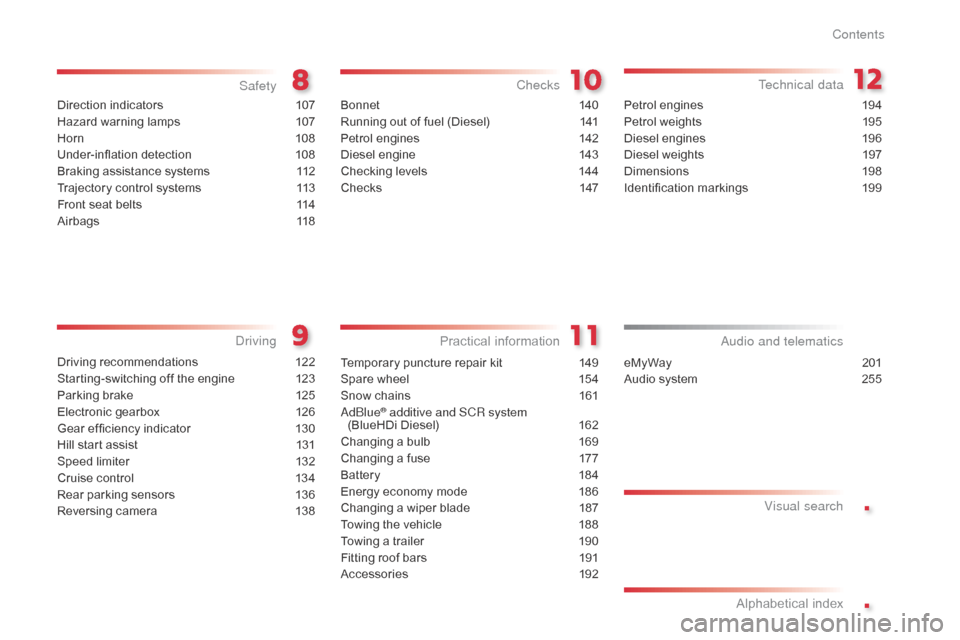
.
.
Direction indicators 107
Hazard warning lamps
1
07
Horn
10
8
Under-inflation detection
1
08
Braking assistance systems
1
12
Trajectory control systems
1
13
Front seat belts
1
14
Airbags
1
18
Safety
Driving recommendations 122
Starting-switching off the engine
1
23
Parking brake
1
25
Electronic gearbox
1
26
Gear ef ficiency indicator
1
30
Hill start assist
1
31
Speed limiter
1
32
Cruise control
1
34
Rear parking sensors
1
36
Reversing camera
1
38
Driving
eMyWay 2 01
Audio system
2
55
Audio and telematics
Alphabetical index Visual search
Bonnet 14
0
Running out of fuel (Diesel)
1
41
Petrol engines
1
42
Diesel engine
1
43
Checking levels
1
44
Checks
14
7
Checks
Temporary puncture repair kit 149
Spare wheel
1
54
Snow chains
1
61
AdBlue
® additive and SCR system
(BlueHDi Diesel) 1 62
Changing a bulb
1
69
Changing a fuse
1
77
Battery
1
84
Energy economy mode
1
86
Changing a wiper blade
1
87
Towing the vehicle
1
88
Towing a trailer
1
90
Fitting roof bars
1
91
Accessories
1
92
Practical information Technical data
Petrol engines 1
94
Petrol weights
1
95
Diesel engines
1
96
Diesel weights
1
97
Dimensions
1
98
Identification markings
1
99
Contents
Page 9 of 296
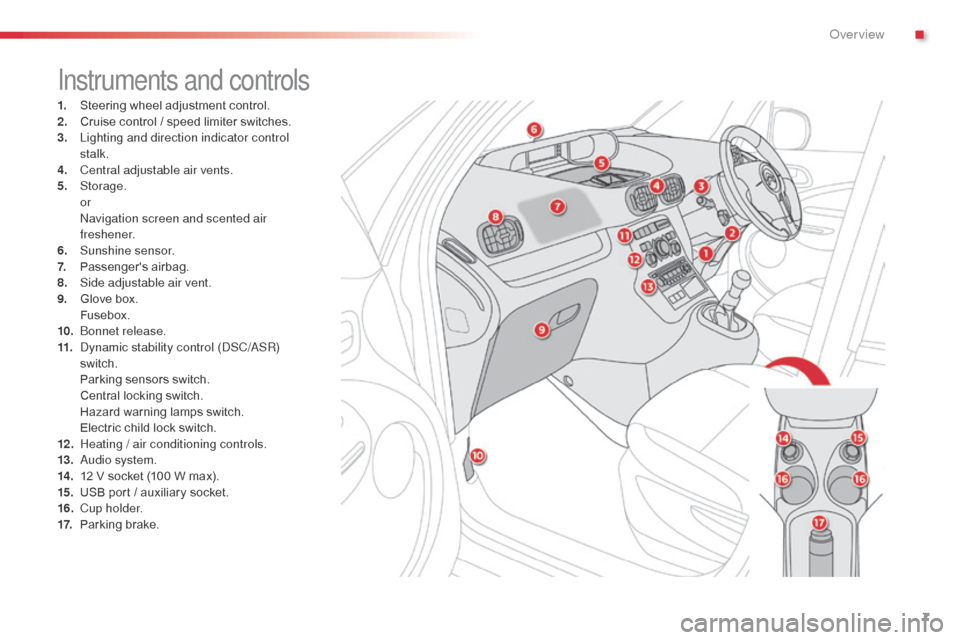
7
Instruments and controls
1. Steering wheel adjustment control.
2. Cruise control / speed limiter switches.
3.
L
ighting and direction indicator control
stalk.
4.
C
entral adjustable air vents.
5.
Storage.
or
N
avigation screen and scented air
freshener.
6.
S
unshine sensor.
7.
P
assenger's airbag.
8.
S
ide adjustable air vent.
9.
G
love box.
F
usebox.
10.
B
onnet release.
11.
D
ynamic stability control (DSC/ASR)
switch.
P
arking sensors switch.
C
entral locking switch.
H
azard warning lamps switch.
E
lectric child lock switch.
12 .
H
eating / air conditioning controls.
13.
A
udio system.
14 .
1
2 V socket (100 W max).
15.
U
SB port / auxiliary socket.
16.
C
u p h o l d e r.
17.
P
arking brake.
.
Over view
Page 11 of 296
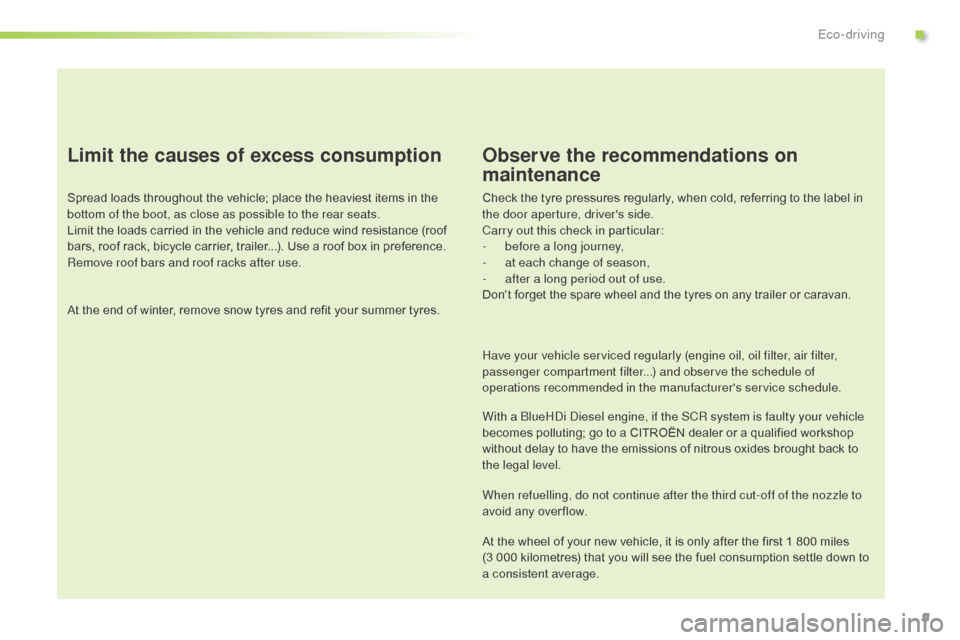
9
Limit the causes of excess consumption
Spread loads throughout the vehicle; place the heaviest items in the
bottom of the boot, as close as possible to the rear seats.
Limit the loads carried in the vehicle and reduce wind resistance (roof
bars, roof rack, bicycle carrier, trailer...). Use a roof box in preference.
Remove roof bars and roof racks after use.
At the end of winter, remove snow tyres and refit your summer tyres.
Observe the recommendations on
maintenance
Check the tyre pressures regularly, when cold, referring to the label in
the door aperture, driver's side.
Carry out this check in particular:
-
b
efore a long journey,
-
a
t each change of season,
-
a
fter a long period out of use.
Don't forget the spare wheel and the tyres on any trailer or caravan.
Have your vehicle serviced regularly (engine oil, oil filter, air filter,
passenger compartment filter...) and observe the schedule of
operations recommended in the manufacturer's service schedule.
With a BlueHDi Diesel engine, if the SCR system is faulty your vehicle
becomes polluting; go to a CITROËN dealer or a qualified workshop
without delay to have the emissions of nitrous oxides brought back to
the legal level.
When refuelling, do not continue after the third cut-off of the nozzle to
avoid any over flow.
At the wheel of your new vehicle, it is only after the first 1 800 miles
(3
000 kilometres) that you will see the fuel consumption settle down to
a consistent average.
.
Eco-driving
Page 21 of 296
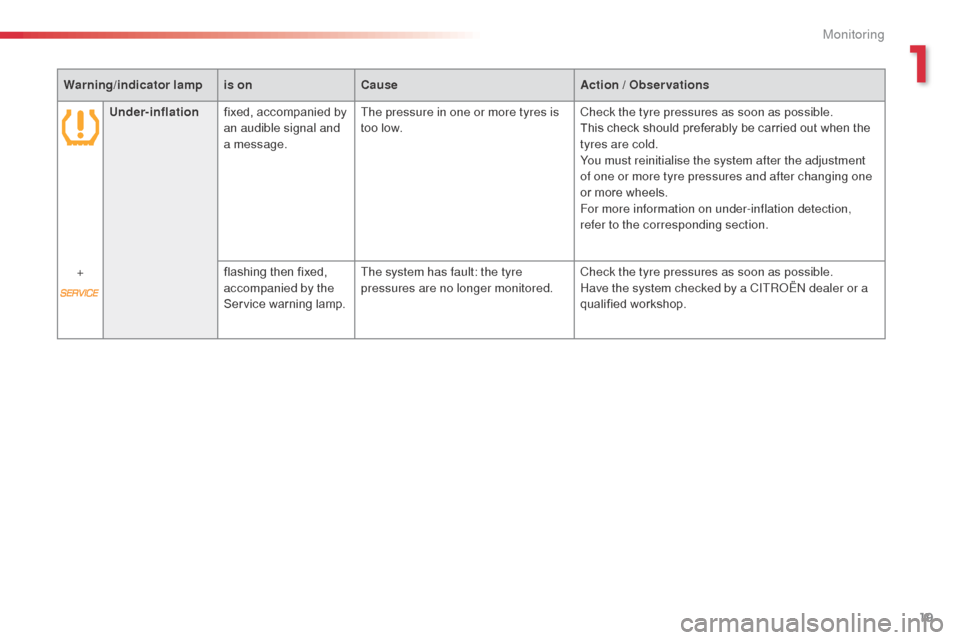
19
Warning/indicator lampis on Cause Action / Observations
Under-inflation fixed, accompanied by
an audible signal and
a message. The pressure in one or more tyres is
too low.
Check the tyre pressures as soon as possible.
This check should preferably be carried out when the
tyres are cold.
You must reinitialise the system after the adjustment
of one or more tyre pressures and after changing one
or more wheels.
For more information on under-inflation detection,
refer to the corresponding section.
+ flashing then fixed,
accompanied by the
Service warning lamp.The system has fault: the tyre
pressures are no longer monitored.
Check the tyre pressures as soon as possible.
Have the system checked by a CITROËN dealer or a
qualified workshop.
1
Monitoring
Page 58 of 296
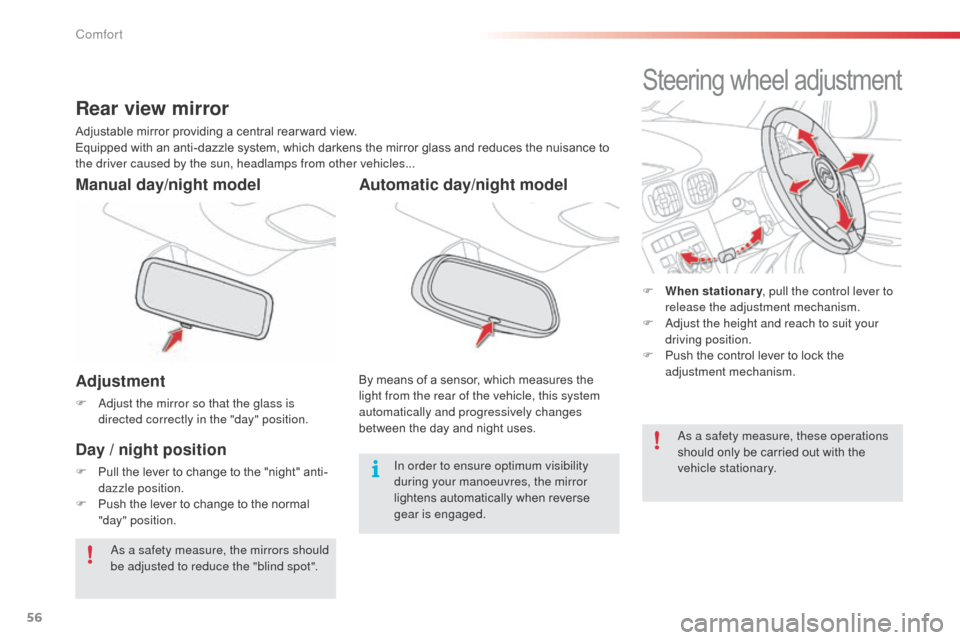
56
Adjustment
F Adjust the mirror so that the glass is directed correctly in the "day" position.
Manual day/night model
Day / night position
F Pull the lever to change to the "night" anti-dazzle position.
F
P
ush the lever to change to the normal
"day" position.
Rear view mirror
Adjustable mirror providing a central rear ward view.
Equipped with an anti-dazzle system, which darkens the mirror glass and reduces the nuisance to
the driver caused by the sun, headlamps from other vehicles...
Steering wheel adjustment
F When stationary , pull the control lever to
release the adjustment mechanism.
F
A
djust the height and reach to suit your
driving position.
F
P
ush the control lever to lock the
adjustment mechanism.
As a safety measure, the mirrors should
be adjusted to reduce the "blind spot". As a safety measure, these operations
should only be carried out with the
vehicle stationary.
Automatic day/night model
By means of a sensor, which measures the
light from the rear of the vehicle, this system
automatically and progressively changes
between the day and night uses.
In order to ensure optimum visibility
during your manoeuvres, the mirror
lightens automatically when reverse
gear is engaged.
Comfort
Page 78 of 296
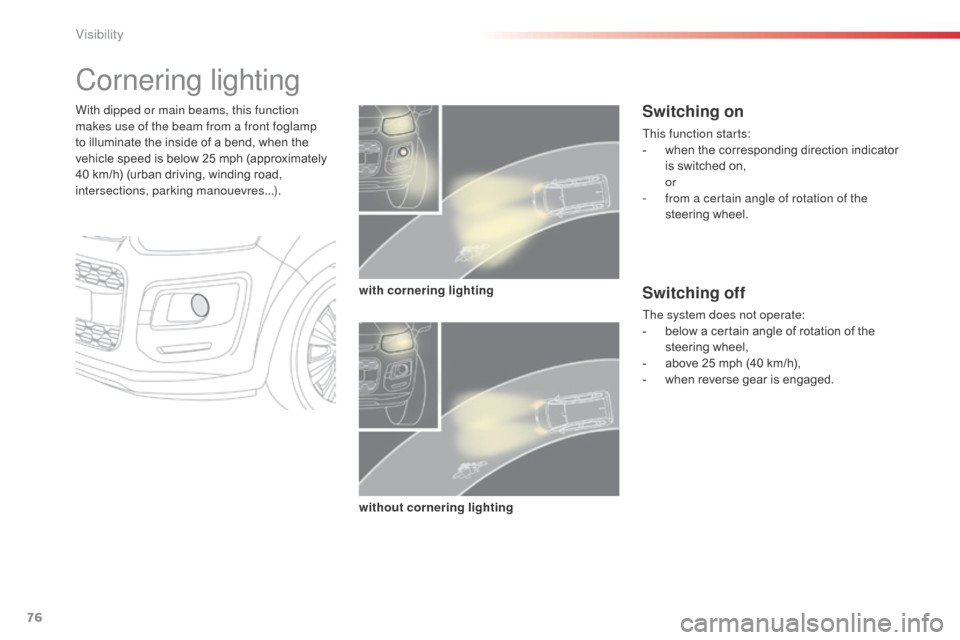
76
Cornering lighting
With dipped or main beams, this function
makes use of the beam from a front foglamp
to illuminate the inside of a bend, when the
vehicle speed is below 25 mph (approximately
40 km/h) (urban driving, winding road,
intersections, parking manouevres...).with cornering lighting
without cornering lightingSwitching on
This function starts:
- w hen the corresponding direction indicator
is switched on,
or
-
f
rom a certain angle of rotation of the
steering wheel.
Switching off
The system does not operate:
- b elow a certain angle of rotation of the
steering wheel,
-
a
bove 25 mph (40 km/h),
-
w
hen reverse gear is engaged.
Visibility
Page 110 of 296
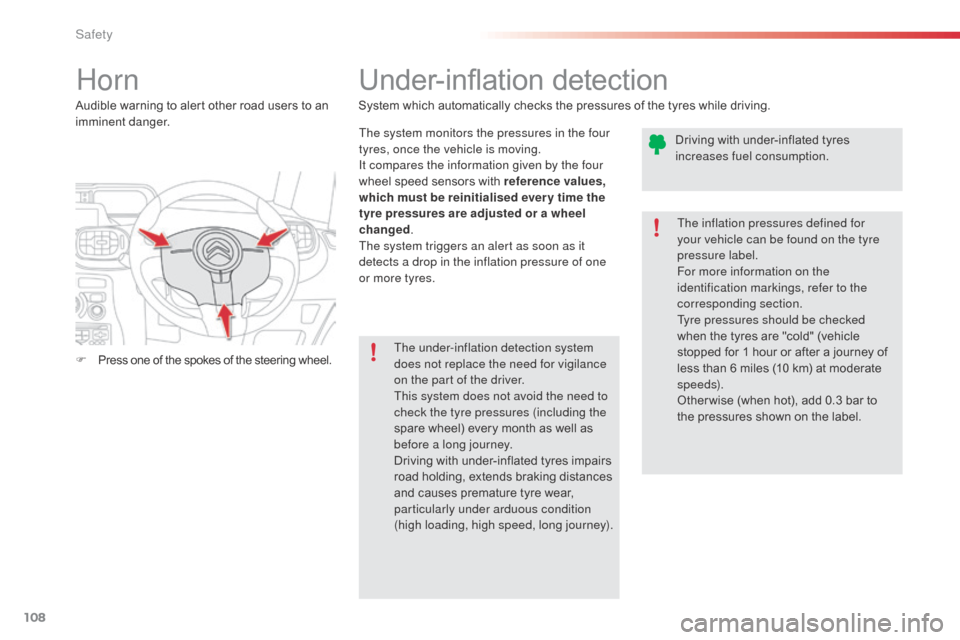
108
Horn
F Press one of the spokes of the steering wheel. Audible warning to alert other road users to an
imminent danger.
Under-inflation detection
System which automatically checks the pressures of the tyres while driving.The system monitors the pressures in the four
tyres, once the vehicle is moving.
It compares the information given by the four
wheel speed sensors with reference values,
which must be reinitialised ever y time the
tyre pressures are adjusted or a wheel
changed .
The system triggers an alert as soon as it
detects a drop in the inflation pressure of one
or more tyres.
The under-inflation detection system
does not replace the need for vigilance
on the part of the driver.
This system does not avoid the need to
check the tyre pressures (including the
spare wheel) every month as well as
before a long journey.
Driving with under-inflated tyres impairs
road holding, extends braking distances
and causes premature tyre wear,
particularly under arduous condition
(high loading, high speed, long journey). The inflation pressures defined for
your vehicle can be found on the tyre
pressure label.
For more information on the
identification markings, refer to the
corresponding section.
Tyre pressures should be checked
when the tyres are "cold" (vehicle
stopped for 1 hour or after a journey of
less than 6 miles (10 km) at moderate
speeds).
Other wise (when hot), add 0.3 bar to
the pressures shown on the label.
Driving with under-inflated tyres
increases fuel consumption.
Safety
Page 111 of 296

109
Under-inflation alert
This is given by fixed illumination of
this warning lamp, accompanied by
an audible signal and, depending on
equipment, the display of a message.
F
R
educe speed immediately, avoid
excessive steering movements and sudden
braking.
F
S
top the vehicle as soon as it is safe
to do so.
The loss of pressure detected does not
always cause visible bulging of the tyre.
Do not satisfy yourself with just a visual
check. The alert is maintained until the system
is reinitialised.
F
I n the event of a puncture, use the
temporary puncture repair kit or the spare
wheel (depending on equipment),
or
F
i
f you have a compressor, such as the one
in the temporary puncture repair kit, check
the pressures of the four tyres when cold,
or
F
i
f it is not possible to make this check
immediately, drive carefully at reduced
speed.
Reinitialisation
It is necessary to reinitialise the system every
time one or more tyre pressure is adjusted, and
after changing one or more wheels.
A label attached to the middle pillar, driver's
side, gives a reminder of this.
Before reinitialising the system, ensure
that the pressures of the four tyres are
correct for the use of the vehicle and in
line with the recommendations on the
tyre pressure label.
The under-inflation detection system
does not give a warning if a pressure is
incorrect at the time of reinitialisation.
8
Safety